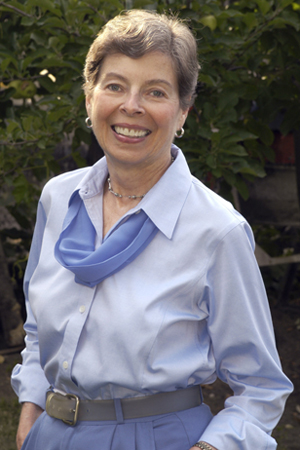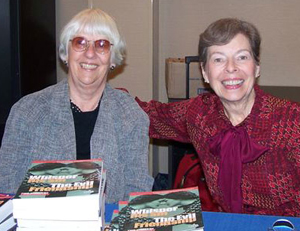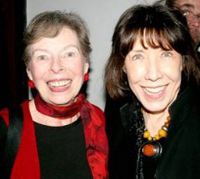
Ann Bannon at home in 2004 / photo by Susan A. Leith
About Ann Bannon
Ann Bannon has been called “The Queen of Lesbian Pulp Fiction” for her landmark “Beebo Brinker Chronicles,” a series of five original paperback novels published by Gold Medal Books in the 1950s and 60s. The books tell the stories of young lesbians in the gay Mecca of pre-Stonewall Greenwich Village. In the intervening years, having gone through many editions and reprints, Ann’s books have become something more than ardent and engaging tales; to a new generation of readers, they provide historical insights into gay life in those faraway days.
When she started writing in 1955, Bannon was a twenty-two year old housewife living in Philadelphia. She found the book that became the inspiration for her own writing on a drugstore shelf: it was Vin Packer’s Spring Fire, a story of two college sorority sisters who have an intense affair. The book sparked a fire in Bannon, only a year out of college herself, and eventually led to her own lesbian narrative. With surprising and welcome help from author Vin Packer, to whom Bannon had written for advice, the manuscript found its way to Richard Carroll, editor-in-chief of Gold Medal Books. Carroll’s suggestions tightened the manuscript and focused it on the romance between the two girls. As Odd Girl Out, it became Bannon’s first published work — the second best selling original paperback of 1957. Bannon followed it up with four others: I Am A Woman, Women in the Shadows, Journey to a Woman, and Beebo Brinker, all published between 1957 and 1962.

Dick Carroll, editor-in-chief of Gold Medal Books, in his office circa early 1950s.
With their colorful covers, their coded blurbs (“twilight, strange, shadows, secret, odd, evil, and warped”), and their lively, passionate heroines, Bannon’s books were quickly discovered by eager readers. They snapped them up from kiosks in train stations, newsstands, and pharmacies, where they were displayed next to the Westerns, the detective stories, and the science fiction. The books were taken home, hidden from censorious eyes, and devoured in secret. From the shy, smoldering Laura to the buccaneering young butch, Beebo herself, the series attracted a devoted following of women hungry to find validation for their lives and their sexuality. Back in the repressive Fifties and Sixties, it was literally a lifesaver for many of them, as the avalanche of letters to Bannon from that era attest.

Ann in 2006 with friend and mentor Marijane Meaker, who wrote “Spring Fire” under the pen name Vin Packer.
Meantime, with the novels completed, Bannon returned to college to earn a master’s degree and finally a doctorate in linguistics from Stanford. She worked as a professor and ultimately an associate dean at California State University, Sacramento, largely unrecognized as a novelist, believing that her stories had run their course. But they kept being re-discovered over the years, and re-issued by different publishers. Occasionally, one of the university librarians would stop her on her way across campus to say, “We just bought a new edition of your books.” Or a student would enter her office, lay a small bouquet shyly on her desk, and say, “I just found out who you are.” Sometimes it was a colleague whose reaction was usually, “No! Really? That was you?”

Ann signing books for author Beverly Hickok (“Aguinst the Current”) / photo by Ann P. Meredith, 2001
Bannon’s marriage had ended in the early 1980s, while she was still in academia. It was not until she retired in the late 1990s and finally had time to travel, lecture, and meet the public, that the reach of her novels began to sink in. Initially, she was promoting the new Cleis Press editions of the Beebo Brinker Chronicles (2001 – 2003) around the country. But before long, a variety of exciting new projects emerged. She appeared on many radio and television interviews, wrote numerous reviews and essays, and found herself, as friends claimed, among those who had “flunked retirement.”
In 2004, the process of translating three of the novels into an award-winning theater piece began. Written by playwrights Kate Moira Ryan and Linda S. Chapman, “The Beebo Brinker Chronicles” stage play had two successful runs in New York in 2007 – 2008, produced first by Hourglass Productions, and then by Harriet Leve, with executive producers Lily Tomlin and Jane Wagner. The play is now starting to appear on theater calendars elsewhere in the country. That the books should have inspired such an affectionate and witty rendering in the new millennium is a tribute any author would treasure.

Ann with “The Beebo Brinker Chronicles” executive producer Lily Tomlin in 2008.
For an entire generation, The Beebo Brinker Chronicles provided the first representation in literature that they had ever read of women loving women. Bannon and others helped to end the isolation and ignorance that had kept thousands of gay women in emotional prisons, and paved the way for the new generation of lesbian writers who were to follow. Over the decades, of all the original lesbian pulp novels authored by women, Bannon’s books have become the most read, the most remembered, and the most often taught. No one is more delighted than Ann Bannon herself at the durability and appeal of these stories from long ago.
Read Ann’s autobiographical introductions to the Cleis Press editions of her books: